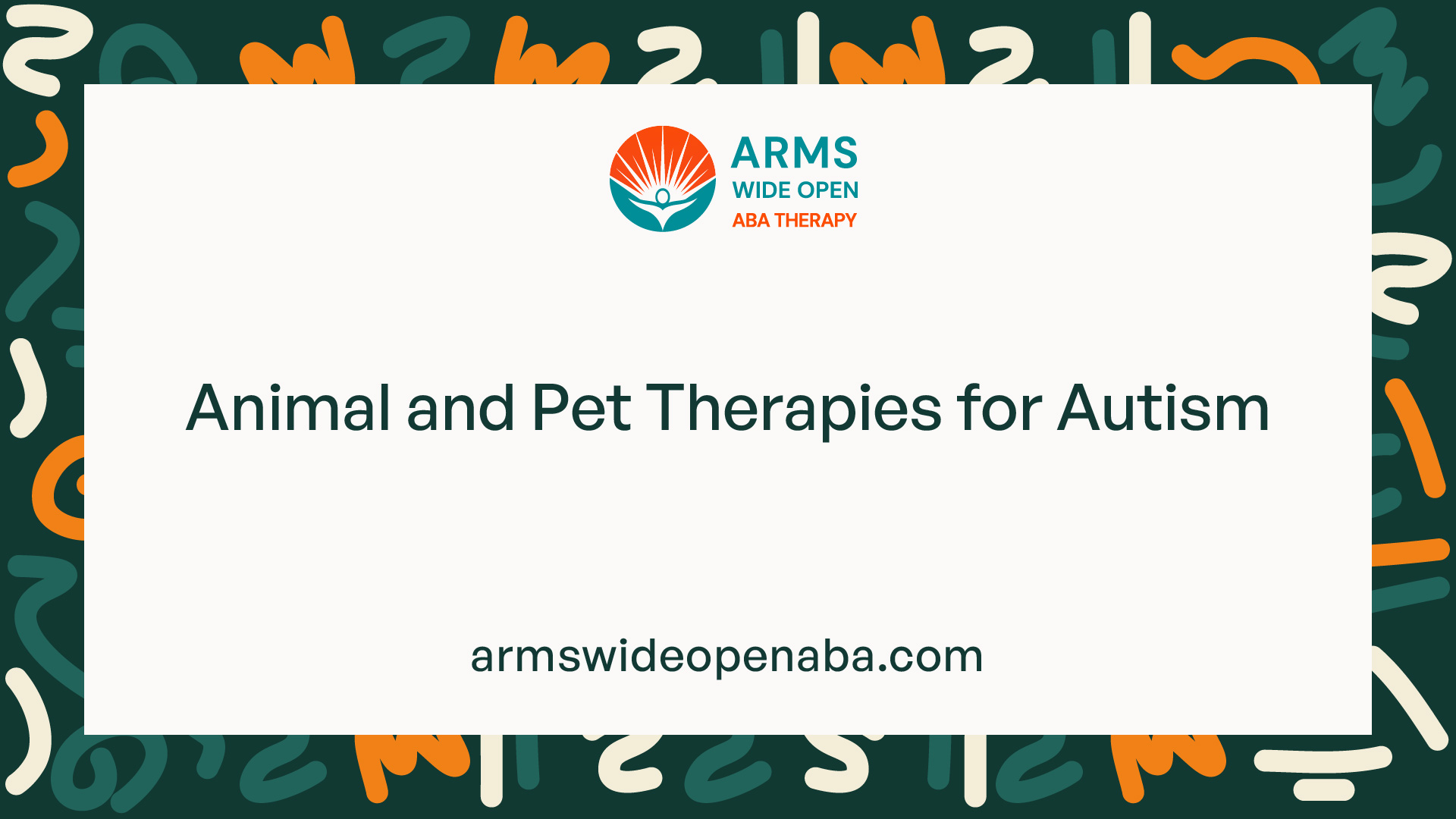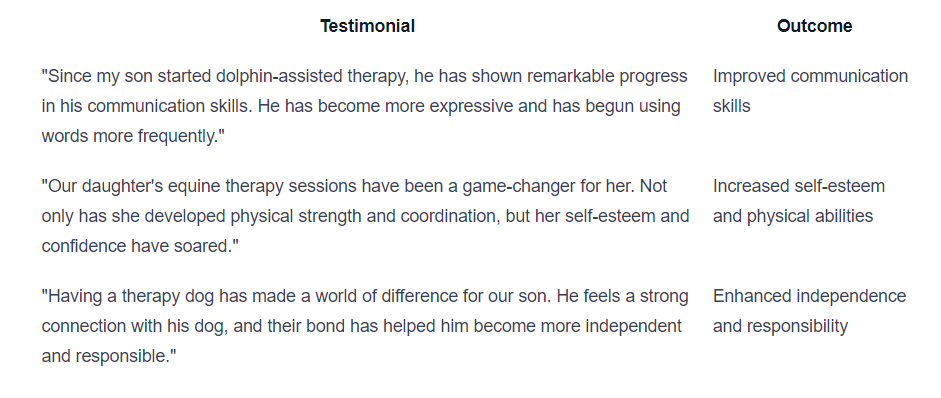Animal and Pet Therapies for Autism
Discover the power of animal and pet therapies for autism. Unleash the potential of furry friends in autism treatment.

Understanding Animal and Pet Therapies for Autism
Animal and pet therapies have shown promising results in supporting individuals with autism. These therapies involve interactions with animals, such as horses, dogs, and dolphins, to provide various benefits for autistic individuals. Understanding the advantages of animal and pet therapies and how animals can help individuals with autism is essential in harnessing the potential of these interventions.

Benefits of Animal and Pet Therapies
Animal and pet therapies offer a range of benefits for individuals with autism. These therapies can:
- Improve social skills and communication: Animals provide a non-judgmental and supportive environment, helping autistic individuals develop social skills, enhance communication, and build emotional connections.
- Reduce anxiety and stress: Interacting with animals has a calming effect and can help reduce anxiety and stress levels in autistic individuals, allowing them to feel more relaxed and at ease.
- Enhance sensory integration: Animals engage multiple senses, providing sensory stimulation that aids in sensory integration and processing for autistic individuals.
- Increase motivation and engagement: The presence of animals can increase motivation and engagement in therapy sessions, as individuals are often highly interested in and motivated by animals.
- Boost self-esteem and confidence: Successful interactions with animals can boost self-esteem and confidence in autistic individuals, as they experience a sense of accomplishment and connection.
Overview of How Animals Can Help Individuals with Autism
Animals have unique qualities that make them well-suited for assisting individuals with autism. Some ways in which animals can help individuals with autism include:
- Non-verbal communication: Animals communicate non-verbally, which can be comforting for individuals with autism who may struggle with verbal communication. This non-verbal interaction can foster a sense of understanding and connection.
- Unconditional acceptance: Animals offer unconditional acceptance and love, providing a safe and non-judgmental environment for individuals with autism to express themselves and form bonds.
- Sensory engagement: Animals engage various senses, such as touch, sight, and sound. This multisensory experience can help individuals with autism develop sensory integration skills and enhance their sensory processing abilities.
- Emotional support: Animals have been known to provide emotional support, offering comfort and companionship to individuals with autism. This support can help reduce feelings of loneliness and anxiety.
Understanding the benefits of animal and pet therapies, as well as how animals can assist individuals with autism, lays the foundation for exploring specific types of animal therapies and their mechanisms in the subsequent sections. By harnessing the unique qualities of animals, we can empower and support individuals with autism on their journey towards improved well-being and quality of life.
Types of Animal Therapies
Animal therapies have shown great potential in empowering autistic individuals. There are several types of animal therapies that have been found to be beneficial in supporting individuals with autism. In this section, we will explore three prominent types: equine therapy, canine therapy, and dolphin-assisted therapy.
Equine Therapy
Equine therapy, also known as horse therapy or hippotherapy, involves interactions between individuals with autism and horses. These gentle and intuitive animals can have a profound impact on individuals with autism, promoting emotional, physical, and cognitive development.
Equine therapy sessions are facilitated by trained professionals who guide individuals through activities such as grooming, riding, and caring for the horses. These interactions can help improve social skills, sensory integration, coordination, and self-confidence.
The rhythmic movements of horses during riding sessions can also provide sensory input, helping individuals with autism regulate their sensory systems. Additionally, the bond that develops between the individual and the horse can foster emotional connections and improve overall well-being.
Canine Therapy
Canine therapy, also referred to as dog therapy or assistance dog therapy, involves the use of trained therapy dogs to support individuals with autism. Dogs are known for their loyalty, companionship, and ability to form strong bonds with humans, making them ideal partners in assisting individuals with autism.
Therapy dogs can assist individuals with autism in various ways, including providing emotional support, improving social skills, and reducing anxiety. These dogs are trained to respond to specific cues and can help individuals navigate social situations, manage sensory overload, and improve communication abilities.
In addition to their emotional support, therapy dogs can also help individuals with autism develop routines, increase their independence, and enhance their overall quality of life. The presence of a therapy dog can create a calming environment and act as a bridge between the individual and the outside world.
Dolphin-Assisted Therapy
Dolphin-assisted therapy involves interactions between individuals with autism and dolphins in a controlled aquatic environment. This type of therapy utilizes the gentle nature of dolphins and the therapeutic benefits of water to facilitate communication, sensory integration, and motor skills development.
During dolphin-assisted therapy sessions, individuals with autism engage in activities such as swimming, playing, and observing dolphins. The rhythmic movements and tactile sensations of being in the water, combined with the presence of these intelligent creatures, can have a positive impact on sensory processing, social skills, and motor coordination.
It's important to note that dolphin-assisted therapy is less widely available and requires specialized facilities and trained professionals. This type of therapy should be approached with caution, ensuring the safety and well-being of both the individuals and the dolphins involved.
By exploring different types of animal therapies, individuals with autism and their families can choose the approach that best suits their needs and preferences. These animal therapies offer unique opportunities for connection, growth, and empowerment, providing valuable support in the journey of individuals with autism.
The Science Behind Animal-Assisted Therapies
Animal-assisted therapies have gained recognition for their positive impact on individuals with autism. Let's explore the mechanisms behind animal-assisted therapies and their specific effects on autistic individuals.
Mechanisms of Animal-Assisted Therapies
Animal-assisted therapies operate through various mechanisms that contribute to their beneficial effects. These mechanisms include:
- Social Interaction: Animals provide a non-judgmental and accepting presence, fostering social engagement and communication skills in autistic individuals. The unconditional love and companionship offered by animals can help reduce feelings of loneliness and improve overall social interaction.
- Emotional Bonding: Bonding with animals can promote the development of emotional connections and empathy. Autistic individuals often find it easier to establish emotional connections with animals, which can then transfer to human relationships.
- Stress Reduction: Interacting with animals has been shown to reduce stress and anxiety levels. The presence of animals can help individuals with autism regulate their emotions, resulting in a calming effect and improved emotional well-being.
- Sensory Stimulation: Animals provide sensory experiences through touch, sound, and movement. These sensory interactions can help individuals with autism develop sensory integration skills, improve motor coordination, and enhance overall sensory processing abilities.
Impact on Autistic Individuals
Animal-assisted therapies have shown promising results in improving various aspects of the lives of autistic individuals. Some key impacts include:
- Social Skills: Interacting with animals can enhance social skills, such as initiating and maintaining conversations, reading nonverbal cues, and developing empathy. These skills can then extend to interactions with peers and family members.
- Communication: Animals can serve as motivators for communication, encouraging verbal and nonverbal communication in autistic individuals. The presence of animals can create a comfortable and non-threatening environment for practicing communication skills.
- Emotional Well-being: Animal-assisted therapies have been linked to improved emotional well-being, including reduced anxiety, depression, and aggression among individuals with autism. The emotional bond formed with animals can provide comfort and emotional support.
- Behavioral Improvements: Animal-assisted therapies have shown positive effects on reducing challenging behaviors commonly associated with autism, such as self-stimulation, aggression, and withdrawal. The structured interactions with animals can promote positive behavioral changes.
It's important to note that animal-assisted therapies should be used as a complementary approach alongside other evidence-based interventions for autism. Collaborating with healthcare professionals and finding the right animal therapy program that meets the individual needs of autistic individuals is essential to ensure safety and maximize the benefits of this therapeutic approach.
Considerations for Implementing Animal Therapy
When considering the implementation of animal therapy for individuals with autism, there are important factors to take into account. These considerations include finding the right animal therapy program and ensuring safety measures and precautions are in place.
Finding the Right Animal Therapy Program
Finding the right animal therapy program is crucial to ensure that the therapy is effective and tailored to the specific needs of individuals with autism. Here are some key factors to consider when selecting an animal therapy program:
- Qualifications and Experience: Look for programs that have qualified professionals with experience in working with individuals with autism. These professionals should have the necessary knowledge and skills to provide effective animal-assisted therapy.
- Animal Selection: Different animals may have varying effects on individuals with autism. Consider programs that offer a range of animal options, such as equine therapy, canine therapy, or dolphin-assisted therapy. The choice of animal should align with the needs and preferences of the individual.
- Program Structure: Assess the structure and duration of the program to ensure that it aligns with the goals and availability of the individual. Some programs may offer short-term interventions, while others may provide long-term therapy options.
- Collaboration with Professionals: Look for programs that emphasize collaboration with healthcare professionals, such as therapists, psychologists, and educators. A multidisciplinary approach can enhance the effectiveness of the therapy by integrating it with other treatment modalities.
Safety Measures and Precautions
Implementing animal therapy requires careful consideration of safety measures and precautions to ensure the well-being of both the individual with autism and the animals involved. Here are some important safety considerations:
- Animal Handling: Trained professionals should always handle the animals during therapy sessions to ensure the safety of the individuals with autism. This helps minimize the risk of accidents or injuries.
- Allergies and Sensitivities: Assess any potential allergies or sensitivities that the individual may have towards the animals involved in the therapy. It is important to consider alternative options if there is a risk of adverse reactions.
- Animal Welfare: Ensure that the animal therapy program follows ethical guidelines and prioritizes the well-being of the animals involved. The animals should be well-cared for, properly trained, and supported by veterinary care.
- Health and Hygiene: Maintain proper hygiene practices during therapy sessions to minimize the risk of infections or diseases. This includes regular hand washing, cleaning of equipment, and following hygiene protocols specific to each animal therapy program.
Implementing animal therapy for individuals with autism can be a beneficial and rewarding experience, but it is important to carefully consider the program and take necessary precautions to ensure the safety and effectiveness of the therapy. By finding the right animal therapy program and implementing appropriate safety measures, individuals with autism can experience the many benefits that animal and pet therapies have to offer.
Success Stories
Hearing real-life experiences and testimonials from autistic individuals who have participated in animal and pet therapies can provide valuable insight into the positive outcomes and benefits of these interventions. These stories highlight the profound impact that animal-assisted therapies can have on autistic individuals, fostering emotional well-being, social connections, and overall quality of life.
Real-Life Experiences of Autistic Individuals
The experiences of autistic individuals involved in animal and pet therapies are diverse and unique. Here are a few examples:
- Case Study 1: Sarah and Equine Therapy
- Sarah, a 10-year-old girl with autism, struggled with social interactions and communication skills. Through equine therapy, she developed a special bond with a therapy horse named Luna.
- Sarah's regular interactions with Luna helped her improve her nonverbal communication skills, empathy, and emotional regulation. She learned to groom, feed, and ride Luna, which boosted her self-confidence and sense of accomplishment. Sarah's parents noticed a significant positive change in her overall well-being and social interactions.
- Case Study 2: Ethan and Canine Therapy
- Ethan, a teenager diagnosed with autism, faced challenges in managing his anxiety and sensory sensitivities. Canine therapy became a crucial part of his treatment plan.
- Ethan's therapy dog, Max, provided a calming presence and emotional support. Max's gentle and predictable nature helped Ethan reduce anxiety and regulate his emotions. Ethan's parents observed that he became more engaged in social interactions and exhibited improved focus and attention.
Testimonials and Positive Outcomes
Testimonials from individuals and their families further emphasize the benefits of animal and pet therapies for autism. Here are a few examples:

These success stories and testimonials highlight the transformative power of animal and pet therapies for autistic individuals. While the outcomes may vary for each individual, the overall positive impact on emotional well-being, social interactions, communication skills, and self-confidence is evident.
By sharing these experiences, we hope to inspire and encourage others to explore animal and pet therapies as a complementary approach to autism treatment. It's important to remember that finding the right therapy program and implementing appropriate safety measures are essential for a successful and safe experience with animal-assisted interventions. Collaborating with healthcare professionals can help ensure that these therapies are integrated effectively into the overall treatment plan for autistic individuals.
Integrating Animal Therapy into Autism Treatment
Animal therapy can be a valuable complement to traditional autism treatment approaches. When integrated effectively, it has the potential to enhance the well-being and development of individuals with autism. Here are two approaches to consider when integrating animal therapy into autism treatment:
Complementary Approaches
Animal therapy can be used in conjunction with other therapeutic interventions to create a comprehensive and holistic approach to autism treatment. Here are a few complementary approaches that can be combined with animal therapy:
- Occupational Therapy: Animal therapy can be incorporated into occupational therapy sessions to address sensory integration, motor skills, and social interaction. For example, interacting with animals can help individuals practice fine motor skills, improve coordination, and develop sensory processing abilities.
- Speech and Language Therapy: Animals can serve as motivators during speech and language therapy sessions. The presence of animals can create a relaxed and non-judgmental environment, encouraging individuals with autism to communicate and engage in verbal interactions.
- Behavioral Therapy: Animal therapy can be integrated into behavioral therapy sessions to reinforce positive behaviors and provide a calming influence. The presence of animals can help individuals with autism learn appropriate social skills, emotional regulation, and empathy.
By combining animal therapy with these complementary approaches, individuals with autism can experience a more comprehensive and tailored treatment plan, addressing various aspects of their development and well-being.
Collaborating with Healthcare Professionals
Integrating animal therapy into autism treatment requires collaboration between animal therapy professionals and healthcare providers specializing in autism. Healthcare professionals such as pediatricians, psychologists, and therapists play a crucial role in ensuring that animal therapy aligns with the individual's specific needs and goals. Collaboration ensures that the therapy is safe, effective, and tailored to the unique requirements of each individual.
Key considerations when collaborating with healthcare professionals include:
- Assessment and Monitoring: Healthcare professionals can conduct initial assessments to determine the suitability of animal therapy for an individual with autism. They can also monitor progress and make adjustments to the treatment plan as needed.
- Goal Setting and Treatment Planning: Collaborating with healthcare professionals allows for the integration of animal therapy goals into the overall treatment plan. This ensures that the therapy aligns with the individual's broader developmental, behavioral, and therapeutic goals.
- Communication and Information Sharing: Regular communication between animal therapy providers and healthcare professionals is essential. Sharing observations, progress reports, and insights helps create a cohesive and coordinated approach to treatment.
By working together, animal therapy professionals and healthcare providers can provide individuals with autism a comprehensive and individualized treatment plan that maximizes the benefits of animal therapy while addressing their unique needs.
Integrating animal therapy into autism treatment requires careful coordination and collaboration between various professionals involved in the individual's care. By combining complementary approaches and working in partnership with healthcare professionals, animal therapy can become an integral part of an effective autism treatment plan.
Sources
https://adultautismcenter.org/blog/animal-therapy-for-autism/
https://www.abacenters.com/animal-therapy-autism/
https://www.goldencaretherapy.com/pets-and-animal-therapy-for-children-with-autism/
Similar articles
We’re here to help you

Our team is here to assist you in this process. Contact us for any assistance.
it’s easy to apply
We Accept Most Insurances
Our in-network insurance partnerships make ABA therapy more accessible to families throughout our service areas.







Our Insurance Process
We'll request your insurance details to help us verify your plan's coverage for ABA therapy. Once we've received this information, we'll walk you through your benefits, including copayments, deductibles and out-of-pocket maximums, so you know what to expect in advance.
Our team will then handle the preauthorization and all the necessary paperwork.
.svg)





















.jpeg)


































.jpeg)




.jpeg)







.jpeg)











.jpeg)
















